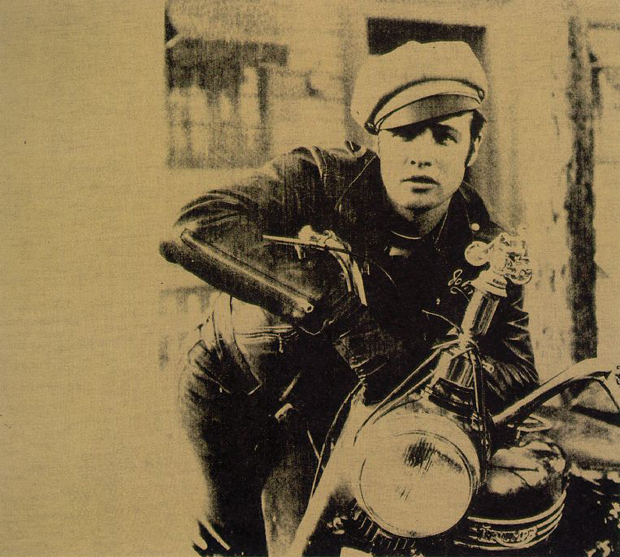“Executed in 1966, Double Marlon is a celebration of a male icon. Warhol has placed the double image of Marlon Brando, taken from his highly influential and controversial 1953 movie The Wild One, at the right-hand edge of a vast, deliberately unprimed canvas.” – William Paton, 2008

Stevan Riley’s Listen To Me Marlon (2015) presents us with another doubled rendering of Marlon Brando. Since Warhol originated his original silkscreen, Brando has lost none of his potency as a visual signifier. Riley clearly understands this, as Warhol did, opting out of any contextualizing prologue in his film, favoring a direct descent into the “mind” of his subject, Marlon Brando. The doubling in Listen To Me Marlon is not a visual one, but one of sound and image. This coupling is one of the foundations of contemporary cinema, though it has been implemented in Riley’s film somewhat unconventionally. That is to say that the images of Brando within the film, culled from motion pictures, news reels, and television broadcasts, rarely partner with the voiceover provided by the late Brando from his own audio journals. Thus is the nature of the voiceover. Where Ken Burns would rely upon Peter Coyote to dramatize the events recounted in a documentary, Riley has the luxury of the subject himself providing “his own” thoughts and recollections.
Andrew Solt’s Imagine: John Lennon (1988) implements the same technical and aesthetic techniques as Listen To Me Marlon. Both films present unique portraits of their subjects in that these films are able to pass as authentic renderings of the subject within the confines of sound and image. However, and this was more evident in Riley’s film than in Solt’s, the audio of the voiceover is actually a patchwork of dialogue edited together. Obviously this is motivated by a need to make the subjects more succinct in their respective recollections and thoughts. But another decisive proponent that often leads to such tinkering is the pressure upon the estates of both Lennon and Brando to preserve the brand they represent. In Imagine: John Lennon May Pang is clearly edited into the relative footnotes of the film whilst Brando’s bisexuality and controversial relationship with fellow actor Montgomery Clift is overlooked entirely. Both films reveal this white-washing in the filmmakers desperate need to make a film that appears all-inclusive of its subject. May Pang is allowed a few fond recollections of her time with Lennon in 1974 while Riley uses a home-movie clip of Brando and Clift “goofing off” together in two brief instances early in Listen To Me Marlon.
The commerciality shared by Imagine and Listen To Me Marlon de-synchronizes the doubling of sound and image in a harmony that is authentic. This is also expressed by Riley’s self-restriction when it comes to Brando’s career, bounding from the early sixties to Coppola’s The Godfather (1972) then to death. Brando the brand that is seen on Turner Classic Movies’ websites and promotional materials, on t-shirts, handbags, buttons, and jackets, is almost always restricted to the Brando of the fifties. This is another signal of Listen To Me Marlon‘s lack of authenticity, as well as its power as a branding device. Consider the effect this film will have as a form of advertisement for the products of the Brando brand?
What Listen To Me Marlon represents that is truly regrettable is that the film did not live up to its potential. The vast scope of the material Brando had recorded onto cassette is astonishing. If that had been coupled with exclusively the 16mm and Super 8 film of Brando’s own home movies then Listen To Me Marlon would have been unforgettable, if not unlike the films of Mark Rappaport. If that had been the case, then the linear core structure of the film could have been replaced with a meditative, meandering one of self-reflection on the part of Brando, dictated by Brando himself by way of his tapes.
Listen To Me Marlon does redeem itself, and not just in its value as entertainment. If one knew very little of Marlon Brando, one would have found Riley’s film informative and even engrossing. Yet its true merits come from Brando’s insights into performance. These insights, peppered throughout the film, are exactly the ideas young actors must be aware of, and these concepts are phrased in the manner that they should be. The instructive possibilities of Riley’s film were something I had not anticipated. The talents of the next generation would do well to have a look at Listen To Me Marlon.
